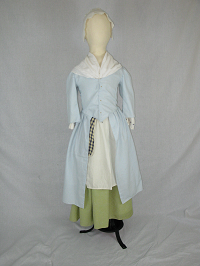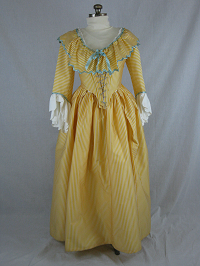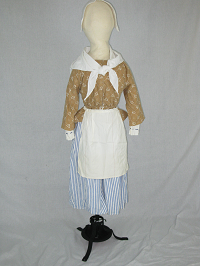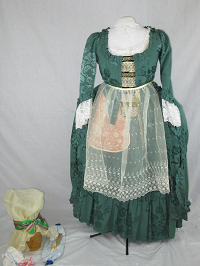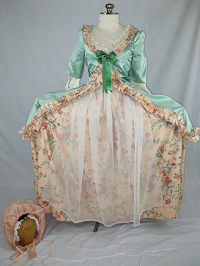
- Details
- Category: 18th Century
- Hits: 2749
1770s
During the 18th century, children were dressed as little adults and simplicity was the rule from 1750-1770. The favored colors were rust, yellow, blue, brown, and plum. Both male and female toddlers were dressed in petticoats; boys did not wear pants until the were 5 or 6 years old. Clothing was constructed with growth in mind, with pleats and drawstrings that could be adjusted as the child grew. To make their backs grow straight, both boys and girls wore boned corsets to counteract the debilitating effects of rickets, a disease that weakened young bones. Boys wore petticoats until they could button and unbutton the many buttons on britches. While the ideal was for all children to wear corsets, typically, this was a luxury that only the gentry could afford.
This gown represents a middling class,the blue gown is pinned down the front with straight pins and hangs loose to show the apron and petticoat. The gown and petticoat were made of linen, as cotton and silk were expensive at this time. The petticoat is of green linen with a striped bodice. The pleats at the bottom of the petticoat are called "peasant pleats" and will probably provide enough length until she is fully grown.
Like the women, girls wore kerchiefs and caps at all times. The shift was the first garment a girl put on. This outfit has a white linen shift with a neck ruffle. Over the shift, came the petticoat, then the apron, pocket, kerchief and gown. The girl's gown shown here is of blue linen.
Click photo for detailed view.
- Details
- Category: 18th Century
- Hits: 2612
1785
This yellow striped silk gown was the newest thing from Paris in the 1780s. New dyes and the availability of silk featured bright colors such as pink, orange, purple, often used together in the same garment. Silk was the investment in a dress of a lifetime. Polite society did not require a lady to be dressed until 2:30 or 3:00 in the afternoon. The mornings were free to write letters or entertain in her boudoir. The new style sparked new construction techniques. This gown has a front fall opening with the front portion of the skirt pleated onto a band that ties around the waist. The bodice is laced together. The neckline is edged with a falling Vandyke collar.
The gown is worn over stays and a false rump or bustle pad stuffed with wool or cork which was tied around the waist. During the 1780s, the style changed from a side to side silhouette to a front back emphasis. Foundation garments helped achieve the proper form.
At a cost of $24 per yard, a silk gauze apron was an immediate indicator of status in 1778; only the “better sort” could afford the sheerest of silks for an apron. Wigs were styled high with hats perched on top. Accessories include a chatelaine, long purse, and fan.
The gown was worn over a pair of stays which forced the woman to stand with elegant carriage. Shoulders were forced back with the arm curving gently away from the torso. A lady lightly rested her hands palms up one on top of the other. The hands were turned slightly in toward the body at the front point of the bodice. The sleeves are constructed to reinforce this curved arm stance. As soon as a little girl could walk, she was put into training stays which disciplined her young body to develop the correct and elegant posture. The hair was piled high with hats perched on top of a large mob cap. Ribbon and lace is tied around the neck, thence the term necklace used today. The purse contains milady’s necessities such as a nose cloth and a snuff bottle. A little snuff was placed in the hollow between the thumb and first finger, then sniffed up each nostril, which would be followed by a sneeze and a sneeze.
Click photo for detailed views.
- Details
- Category: 18th Century
- Hits: 2821
1770s
During the 18th century, children were dressed as little adults and simplicity was the rule from 1750-1770. The favorite colors were rust, yellow, blue, brown, and plum. Both boys and girls were dressed in petticoats until they were 5 or 6 years old. Clothing was constructed with growth in mind with numerous pleats and drawstrings that could be let out as needed to accommodate the growing child.
This outfit represents the middling class, perhaps a German farmer’s daughter on the Pennsylvania frontier, in a resist-print short gown closed down the front with straight pins.The petticoat is blue and white striped linen. The pleats at the bottom of the petticoat were let down as the girl grew. The average height of a woman in the late 18th century was 5 feet.
A chemise of white linen serves as the under garment. When needed, sleeve extensions could be laced over the chemise sleeves.
The kerchief, apron, shift and cap are white linen.
Children ran barefoot in the country. The only shoes were hand-carved wooden clogs that did not differentiate between left and right. These were only worn in cold weather. Hand knit stockings provided warmth and made the clogs more comfortable. It wasn’t until the 1850s that shoes were made with a left and a right foot. Saying you don’t know your left foot from your right foot stems from this change.
While the adults wore caps at all times, it wasn’t until the age of 16 that a girl became of age and was given her bonnet.
Click photo for detailed views.
- Details
- Category: 18th Century
- Hits: 2733
1770s
Clothing was the showcase of your social status. By one or two glances you could tell how much money a man had. Clothing his wife, family and servants in the best he could afford was paramount to the English and French man who settled in America. Women displayed their handiwork for all to see in the guise of pockets, pocket books, and other accessories. Widows wore their embroidered pockets, aprons, and kerchief so the gentlemen could see their proficiency in this craft.
An apron kept her petticoat clean. Worn for support, the stays, or corset, pulled in the waist and flattened the front. To help with this, a busk was placed in a pocket down the front. These busks of wood or whale bone were handsomely carved, inlaid, and presented by a beau. The laces up the back allow for expansion. If you gained more weight, the sides can also be opened and laced. Bodices were cut very low so they devised ways to hide cleavage. Modesty vases, and bosom bows were placed center front.
Corset making was usually a man's profession because of the strength needed to stitch through the heavy materials. Made very narrow through the back, the stays forced the shoulders back into the position proper for the era. Beneath the corset, a bosom buddy acted like today’s underwire bra. It was made of linen stuffed with wool.
The hygiene of the 18th century included few baths. A woman carried a pomander to mitigate the inevitable odors, filled with lavender or spices from the garden. A wealthy woman could afford perfume from France. On the chatelaine with the pomander is a pin ball, key, needle case, and scissors.
An extra petticoat could be worn and pulled up to look wide side to side. Petticoats were constructed of five widths of material approximately 105 inches in diameter. The side slits allow access to the pockets beneath. When the bottom became ragged, a tuck could be let down.
Beneath the corset and petticoats is a chemise. It was constructed without a pattern of three rectangles. One extends from the hem in front up across the shoulder and down to the hem. The other rectangles are the sleeves. Gussets under the arms allow more freedom of movement and a drawstring adjusts the neckline to fit any gown. Stockings were hand knit and held up with garters. Shoe buckles were one of the first pieces of jewelry a woman would acquire and made of gold, silver, brass, or pewter. When a shoemaker was not available, clogs were more durable.
This fancy gown would be appropriate for a grand ball. Underneath is a blue chemise of polished cotton, with a blue ribbon girdle. From it hangs a chatelain with such necessities as a key, needle case and pomander containing a perfumed ball of cotton. During the 18th century, the chemise was not only worn as a morning dress but also as a nightgown and under other garments. It was constructed of 3 rectangles. The largest one extends from the hem up over the shoulder and down the back. This rectangle was shaped by taking a triangular piece from the shoulder area and adding it to the bottom of the skirt. The sleeve rectangle was attached with a gusset set under the arm for ease of movement. The neck is gathered and the lace frill is called a tucker. The sleeve ruffles will show under her gown. No other garment was worn under the chemise except on cold days. An extra petticoat was added and tucked in at the waist. Could this be the hint of bloomers to come?
Hoops have taken many shapes over the years. These are small and will hold the dress out at the side, while giving a flat figure from front to back. Whale bone or oak splits were used as stiffening. Another figure enhancer was the bosom buddy, or chest protector. Stuffed with wads of wool it added warmth in winter as well as curves.
This style of dress was popular from 1750 to 1785, and was called Robe à la française by the French. The original gown would have been laced up the back but for convenience we have added a zipper. Materials have been researched and while sometimes it was impossible to obtain the original material, cloth was selected that was as close as possible to the original in texture and design. The chemise lace is pulled out and is now the decoration for the robe. The same chemise might be worn under different style necklines by adjusting the drawstring in the neck. This gown gives a pleasant effect with its narrow waist, wide hips, and a train that falls from the shoulders. About the time of the American Revolution, the hair styles were so extremely high one lady went to a ball with her head out the carriage window. Because of the time needed to install rats, wads of wool, curl the hair and apply grease and powder, my lady might wait a month before having her hair re-styled. A head scratcher was a necessity. Head coverings were worn at all times, and differed with each activity. Mob caps were popular and as hair styles became more elaborate the caps became larger. This one of blue organdy has a hand-tatted edging and a white satin bow. A bit of neck lace and fingerless mitts of lace complete the look. A long purse and a cape complete the ensemble.
Click photo for detailed views.
- Details
- Category: 18th Century
- Hits: 2749
1770s
The last quarter of the 18th century produced an amazing variety of fashions. One of these was the polonaise. This term refers to an overdress that was cut like the man’s coat of the same period. It is tied across the bodice with bows resembling a ladder. This is a copy of a court gown worn by Madame Pompidou. Although the colonists wanted to be separate from Europe, they were quick to mimic their fashions.
The front and underarm of the bodice is cut in one piece with no side seams. The bodice is closed only at the top of the center front, and falls back in slight folds showing the stay or corset and the petticoat. The center back and two far back seams end in inverted pleats which are accented with black cording, tassles and buttons. There are two loops of fine braid attached to the inside for looping up the skirt. The edge of the polonaise is trimmed with 21 yards of ruched chintz. A bosom knot hides cleavage. The tippet is used to conceal the deep neckline. Necklace was just that - a piece of lace tied around the neck.
This green polonaise was popular in the 1770s. The lady’s social status is immediately apparent. The cost of material for a petticoat and gown with matching box pleated trim would be great. One diary of a lady of the court talks about having the milliner redecorate the same gown for six years. This silk brocade would be an investment of a lifetime. The apron as well as her lace gloves tells everyone who sees her, she need do no work except needle work. Indispensables such as a fan and looking glass are kept in her long purse. The gown has a train which can be drawn up by use of strings. Hooks and eyes close the front of the gown. The colonists imported all the fancy materials. George Washington imported many fancy gloves for Martha and her daughter.
A scarf is used to conceal a deep neckline. The corset, which serves as the bodice of the gown, is of rose brocade and heavily boned. The long point in front kept the figure straight below the waist. Hair styles of the 1770s were very elaborate and time-consuming with stiff curls piled high, plastered and sometimes powdered. They were left intact for several weeks. The result of this was a sanctuary for parasites. To relieve the itching caused by these insects, a fork-like implement was invented. The doremeuse cap with lappets is shirred lace and has a black bow. To protect the extreme hairdo from the elements, ladies wore a bonnet called a calash. If folded flat, like the carriage hood that is was named after for ease in storage. Lace gloves were also a status symbol to cover the hands.
In 1776 there was no clear-cut definition of what was outerwear and what was underwear. At this period, the undergarment was merely the part of the costume worn under the outer garment. For the foundation of this costume, the chemise could also serve as night wear. It has a drawstring at the neck with a lace ruffle. This allows it to be adjusted to fit the neckline of any gown. The sleeves are finished with lace ruffles. Around the waist are a set of pockets and a ribbon girdle, which is not as constraining as the girdles of the 1940s. From the girdle hangs a chatelaine, which had been worn for many years previous to this era as jewelry with a purpose. On this one we see a key, a pomander containing cotton scented with French perfume, and a snuff bottle. Ladies would place a little snuff in the hollow between the thumb and first finger then sniff a little up each nostril, which would be followed by a sneeze and a sneeze. Pockets were worn singly or in pairs. These were tied around the waist and contained many necessities.
Click photo for detailed views.
Page 2 of 4
